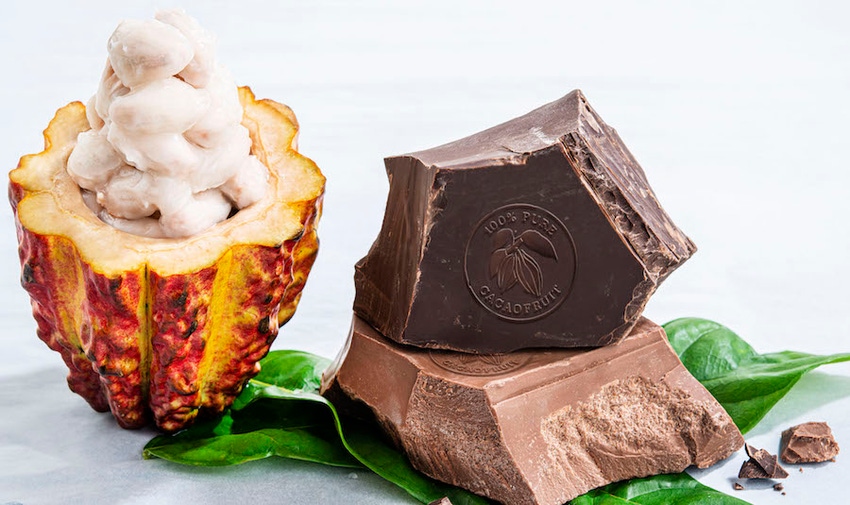Food Firms Go All In on Reduced-Sugar Chocolate in 2019
October 4, 2019

Sugar is on the outs as consumers turn to healthier food and snack choices. At the same time, medical professionals are calling public attention to health concerns linked to sugar consumption like obesity and diabetes. Food manufacturers are embracing the shift. In the confectionery category, chocolate producers are responding to the trend by developing a variety of reduced-sugar products.
Several major hurdles have to be overcome to make reduced-sugar chocolate a marketable product, however: Sugar not only gives chocolate its sweet flavor, but it also plays a huge role in its creamy texture. Furthermore, some reduced-sugar chocolate products are formulated to meet the criteria of sugar reduction claims, like “30% less sugar” or “no added sugar,” while other recipes were developed to showcase better-for-you ingredients.
To solve these issues, chocolate manufacturers are doing everything from turning to alternative ingredients and altered forms of sugar to sweeten and texturize their products to developing new sugar alternatives and product formulations.
WHY NOW?
Demand is high for reduced-sugar chocolate and the chocolate industry now has the ability to manufacture compelling, quality products.
Research shows that consumers across the globe are turning away from sugar, particularly in confectionery and chocolate products. A 2018 survey by Ipsos found that 69% of Americans and 73% of Canadians are concerned about the sugar content in candy products. White sugar was the top item that consumers in Canada said they wanted to remove from their diets.
The low-to-no-sugar segment is potentially profitable as well. A study conducted by Cargill this year found that 54% of consumers will spend more on a product with no or reduced sugar. Demand for reduced-sugar confectionery products is growing at about twice the rate of the market for traditional chocolate confections, according to market insights firm Euromonitor.
In light of the growing consumer trend, several prominent confectionery and chocolate firms made a public pledge in 2017 to reduce the amount of sugar in some of the firms’ products sold in the U.S. by 2022. Sweets makers Ghirardelli, Russel Stover, Ferrara, Lindt, Nestle, Wrigley, and Mars committed to making half of the individually wrapped products they produce contain 200 calories or less. Hershey Co. also announced a similar plan that year.
While such efforts to release reduced-sugar chocolate products have been underway for several years, 2019, in particular, is shaping up to be a major year for the category. Nestle, Barry Callebaut, Cargill, Mondelez International, and Strauss Group all made announcements regarding reduced sugar chocolate products this year.
PUTTING THE CACAO FRUIT ON DISPLAY
Cocoa and chocolate manufacturer Barry Callebaut released its WholeFruit chocolate, made from 100% cacao fruit, this September. Slated to reach U.S. stores in May 2020, the product contains 40% less sugar than the majority of dark and milk chocolates on the market, according to the Swiss company, and has more than 90% more fiber compared to most conventional chocolate.
“Our goal in R&D is to develop innovations that are on trend, satisfy unmet consumer needs and also taste great," Pablo Perversi, chief innovation, sustainability, and quality officer for Barry Callebaut said in a company release. "WholeFruit chocolate scores on all three points. It will respond to the need of millennials and centennials for ‘healthy indulgence’ just like our Ruby chocolate, launched in 2017, meets the need for ‘hedonistic indulgence.’”
Barry Callebaut’s introduction of the new cacao fruit-based chocolate comes on the heels of Nestle’s July debut of a 70% dark chocolate bar made completely from cacao beans and pulp. To produce the refined-sugar-free product, Nestle said it dries and pulverizes cacao pulp using a patented process.
“We’re proud to bring chocolate lovers a new chocolate made entirely from the cocoa fruit without adding refined sugar,” Paula Bula, head of strategic business units, marketing, and sales at Nestle, said in a release announcing the product’s roll out. “This is a real innovation [that] uses the natural sweetness of the cocoa pulp to provide a pure, novel chocolate experience.”
The food and beverage giant plans to debut the product in Japan this fall. Additional markets around the world will get a chance to try the new chocolate sometime in 2020.
FIBER IS BECOMING A MAJOR INGREDIENT
Dietary fiber is one ingredient used to produce reduced-sugar chocolate with a texture comprable to that of conventional chocolate. Israel-based Strauss Group, for example, announced in September the creation of a new refined sweet milk chocolate bar that has 30% less sugar. The bar substitutes some sugar with 5% ground tiger nut flour for sweetness and 17% dietary fiber for texture.
Likewise, in July, Mondelez International introduced a new version of its Cadbury Dairy Milk chocolate bar with 30% less sugar in the UK in July, calling the product, “the most significant innovation in the brand’s history.” The recipe uses soluble corn fiber to retain the texture of the original Cadbury Dairy Milk bars.
“We’ve recognized that there is an increasing trend for people wanting to manage their sugar intake and that’s why we have worked tirelessly to create a Cadbury Dairy Milk bar with 30% less sugar, which still tastes great,” brand manager Katrina Davison said in a company release. “We are committed to responding to relevant consumer trends, and are always striving to offer chocolate lovers greater choice through exciting innovations and portion control offerings.”
INVESTMENT IN NEW PRODUCTION ASSETS
As a testament to the strength of this trend, companies are shelling out big money to support changing production needs. American agribusiness Cargill, for instance, announced in late September that it is investing $5 million to add new production capabilities for reduced-sugar chocolate at its Mouscron, Belgium chocolate manufacturing plant.
“As more consumers look for reduced-sugar chocolate products, our customers are looking for new chocolate recipes that combine an indulgent sensory experience with lower sugar levels,” Inge Demeyere, managing director of Cargill’s chocolate activities in Europe said in a company release. “Cargill is able to deliver on that ask thanks to our unique R&D approach. Leveraging a deep chocolate and broad food ingredients expertise, Cargill created a unique sugar reduced chocolate recipe capability using an optimized blend of sugar replacers, while still managing to get all the other elements like taste and texture right. Our new, bespoke sugar reduced chocolate capabilities can produce a creamy, rich, indulgent chocolate taste with just the right level of sweetness.”
The expansion will include dosing systems that will enable Cargill to lower sugar levels over time, helping companies to include a sugar-reduction claim on their packaging. Capabilities will also be added to the site to allow for the use of a range of sugar-replacement ingredients.
With all the recent developments in reduced-sugar chocolate this year, food manufacturers that use chocolate in their products may want to consider the "sweet opportunities" of this growth segment for 2020.
For more news headlines, articles, and equipment reviews, visit our Equipment Zones
More Confectionery Industry articles:
You May Also Like


